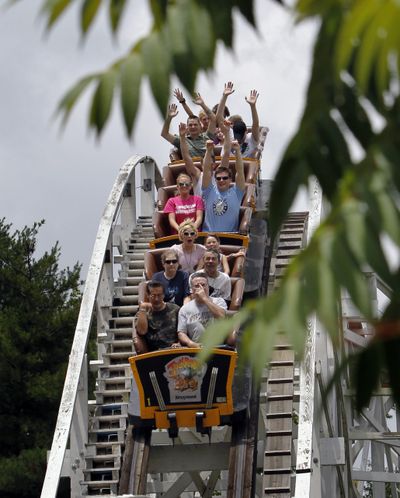Crowds are back at amusement parks

TOLEDO, Ohio — Amusement parks thrown for a loop by the slumping economy over the last few years are starting to rebound, drawing bigger crowds and spending more money on new attractions and shows this season.
Crowds increased at many of the nation’s parks in 2010, with some seeing record attendance. Profits were up as families sought out fun close to home and began traveling again. Better weather helped, too.
Those within the amusement industry are optimistic this year will be even better and think rising gasoline prices might even help them out by forcing families to spend their vacation time near home.
“We would love to take them to Disney, but right now there’s no way we can do it,” said Carrie Bridgewater, of Corydon, Ind., who has six children ages 18 to 3 months. Instead, they make an annual trip to Holiday World in southern Indiana.
The two biggest operators of regional amusement parks — Six Flags Entertainment Corp. based in Grand Prairie, Texas, and Cedar Fair Entertainment Co. based in Sandusky, Ohio — both reported attendance was up nationwide last year. Other regional parks also saw at least modest gains while Disney parks in the U.S. dipped a bit.
For many, it was a bounce back year after “two of the most depressed years we’ve seen in the last 35 years,” said Dennis Spiegel, a theme-park consultant who is president of Cincinnati-based International Theme Park Services Inc.
Amusement parks are often thought to be recession-proof because they offer a relatively affordable full day of entertainment, with daily adult tickets normally ranging from $35-$50. But that didn’t hold true in 2008 and 2009, as attendance and revenues at many big parks flattened out or fell, and several companies made moves to sell parks in order to pay off huge debt.
Six Flags, which has 19 parks in North America, brought in 24.3 million visitors, an attendance jump of just under 1 million, because of the growth of its Halloween and Christmas events. Just over half of its attendance increase came during the last three months of the year.
Visitors also spent more money on cotton candy, hot dogs and souvenirs. The year before, Six Flags saw attendance fall by 1.5 million people.
Cedar Fair, with parks that include Cedar Point and Kings Island in Ohio and Knott’s Berry Farm near Los Angeles, hit an all-time high, drawing 22.8 million people, an increase of 1.7 million. Hotel stays were up, too.
Walt Disney Co., the nation’s largest amusement park operator, reported attendance was up at Disneyland in California, but dropped at Walt Disney World resort in Florida in 2010 after one of its main competitors, Universal Orlando, enjoyed a big attendance jump with the opening of The Wizarding World of Harry Potter attraction.
Disney didn’t release specific attendance numbers, but did say crowds picked up the last three months in Florida. Hotel bookings for the year also were down.
Regular adult admission costs $82 at both Disney World and Universal Orlando, although prices do come down with multiple-day options. Disney World offered a number of package deals including free meals and hotel discounts during the economic downturn, but it did raise ticket prices in August.
Universal Orlando said its visitor count jumped from 9.3 million to 11.2 million last year.
Better weather during the summer and fall across much of the country was a big factor in the better attendance numbers last year. The past two years had been rainy and cold, dampening attendance in many parts of the country, Spiegel said.
“As the economy continues to improve, we see families maybe traveling a little more,” said Colleen Mangone, a spokeswoman for the International Association of Amusement Parks and Attractions, based in Alexandria, Va.
Families are watching their money more closely and no longer are willing to risk spending money on an amusement park outing if a chance of rain is in the forecast, said Pete Owens, spokesman for Dollywood theme park in Pigeon Forge, Tenn.
Dollywood, just outside the Great Smoky Mountains National Park, saw bigger crowds throughout the summer and fall, but heavy snow hurt attendance over the holidays, Owens said.
Amusement parks are trying new ways to get more repeat visitors. Six Flags is allowing season pass holders at some parks to pay in installments — prices vary by park. One of the nation’s oldest parks, Kennywood, near Pittsburgh, began selling season passes last year for the first time in its 112-year history.
And parks are spending more on new rides and attractions this year than the previous season, said Gary Slade, editor and publisher of Amusement Today, a trade publication.
“Everybody is beyond positive,” said Slade.
New roller coasters are opening at Busch Gardens in Tampa, Fla., and at Six Flags Over Georgia near Atlanta. Legoland Florida will open in October south of Orlando. Several other parks are making new additions to their water attractions.
The emphasis now is on adding family attractions, such as water rides that seat four people rather than big roller coasters that appeal more to teens and young adults.